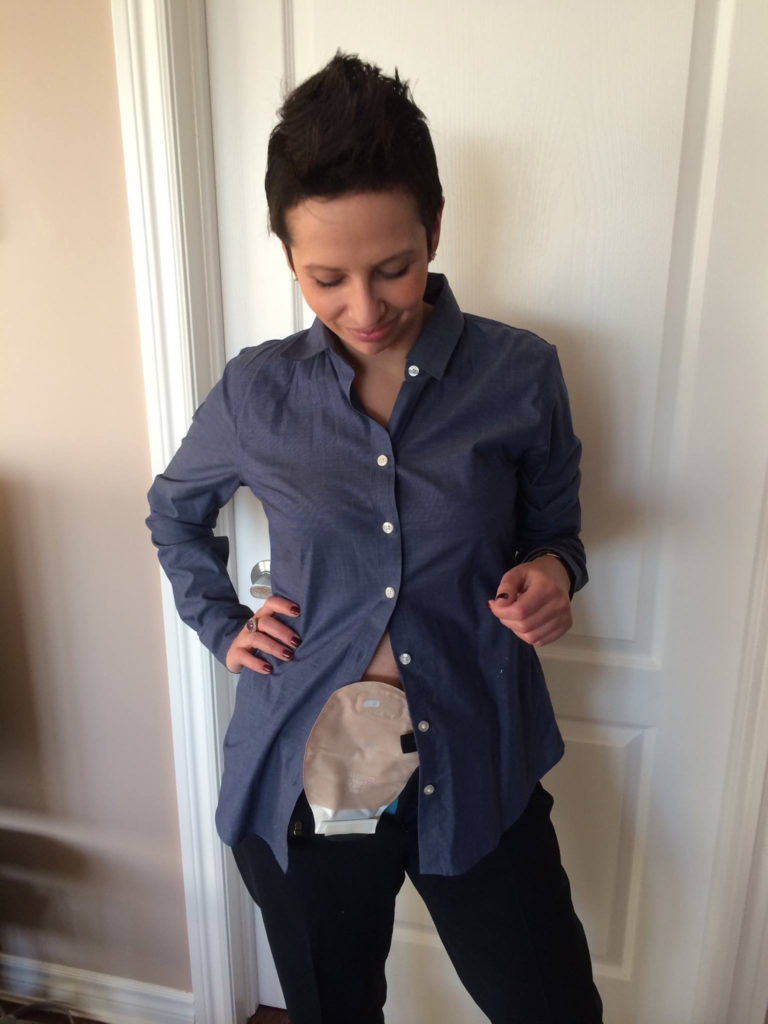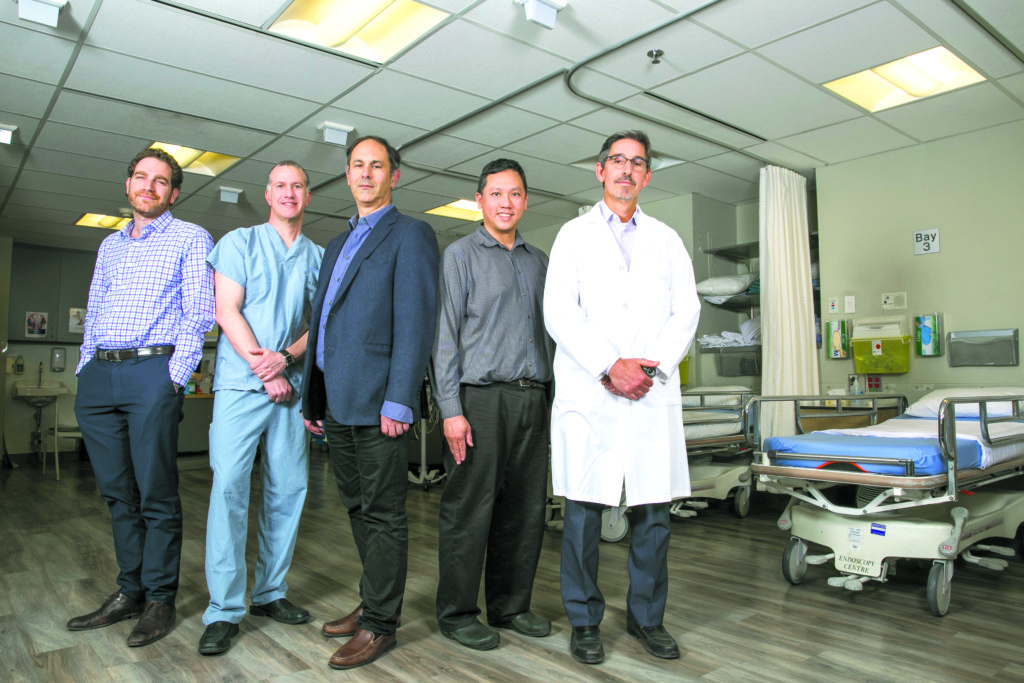“The pain is sometimes excruciating. The lost productivity is frustrating. And the notion that the disease is incurable is infuriating,” said Melissa Lantsman, a sufferer of Crohn’s disease, a chronic form of Inflammatory Bowel Disease (IBD) that often requires bowel surgeries, long-term medication plans and changes in lifestyle.
Lantsman, who was one of the organizers of the inaugural Brews of The 6ix event in Toronto last February that raised $21,000 for Crohn’s and Colitis Canada (CCC), a national charity committed to finding a cure, spoke to The CJN about how she copes with the disease that affects a disproportionate number of Jews, and why she volunteers her time to spread the word.
“I was diagnosed with Crohn’s officially in 2014, but I’ve had a stomach ache since about 1999,” she said.

Lantsman hopes the Brews of The 6ix event she co-chaired with Daniel Warner, Montana Skurka and Jessica Taylor will educate the public about the need for a cure.
READ: DO JEWS HAVE AN UNHEALTHY RELATIONSHIP WITH SEX?
“There is no way to prevent Crohn’s disease, but until there is, we have to keep talking about it; we’ve got to keep raising money to find a cure and we hope that our community, our networks, a bunch of young professionals who suffer from it, who have a friend or family member who suffers from it; will step up to help those who are living with it,” she said.
‘According to a 2009 study at the University of Birmingham, Ulcerative colitis is three to five times more common in Jews than in non-Jews living in Western countries’
“We step up in every other facet of our community and Crohn’s is one of those diseases that sort of has a stigma around it.… It doesn’t kill you, but it certainly doesn’t do anything for your quality of life.”
Lantsman has undergone two surgeries, was outfitted temporarily with an ostomy pouch that diverts waste from the intestines into a bag and is currently on a treatment plan that helps to keep flare-ups at bay. She said she is able to manage the disease through diet and other factors.
In a mass email to those he invited to the Brews of The 6ix event he co-chaired, Warner described his own battle with IBD, which began when he contracted an intestinal bacterial infection from eating tainted shawarma in Israel.
“The infection caused considerable abdominal pain and did serious damage.… I was hospitalized at Mount Sinai (Hospital in Toronto) for a week,” he wrote.
He said he was able to manage his symptoms for the following four years with medication, but when he was no longer able to ignore his worsening symptoms, he sought medical treatment and was diagnosed with Crohn’s disease. He was admitted to Mount Sinai for nearly a month.
“It wore me down physically and mentally.… I went on steroids, had three blood transfusions, 10 iron infusions and lost 30 pounds.… I was exhausted … I couldn’t sleep, didn’t want to eat and I was so weak that I couldn’t walk for more than a few minutes,” he recalled.
“I was released after trying a new medication called Remicade.… Once you start it though, you’re signed up for life. However, it finally helped me get back to normal and I’ve been taking it every four to six weeks since, through an IV infusion.”
Like a number of other diseases, studies show that IBD affects the Jewish population at a significantly higher rate than the general population.
According to a 2009 study by Ahmed M. El-Tawil at the University of Birmingham, “Ulcerative colitis is three to five times more common in Jews than in non-Jews living in Western countries. In Israel, Ashkenazi Jews have a higher incidence than Sephardi Jews, but a lower incidence than Ashkenazi Jews in the United States or Northern Europe.”
‘There has to be something in the water, so to speak, in Canada, because we have the largest incidence of IBD in the world’
A 2012 study published in the journal PLOS Genetics explored Ashkenazi Jews’ susceptibility to Crohn’s and detected “several (genetic) variants associated with the increased risk of Crohn’s disease” in Jews.
Dr. Zane Cohen – an internationally recognized colorectal surgeon who spent much of his career at Mount Sinai and who specializes in treating patients with IBD and colorectal cancer – said Jews in Canada may be even more susceptible.
“There has to be something in the water, so to speak, in Canada, because we have the largest incidence of IBD in the world. It seems to be the highest incidences are in northern countries, so, for instance, Canada is high, (the) U.S. is high, Scandinavian countries in particular are very high, Belgium, Holland,” Cohen explained.

“One of the theories is that because it’s cold, they may not be exposed to as many bacteria… because they’re not outside as much and therefore they’re more susceptible to the development of these inflammatory diseases, but it’s really a hypothesis only.”
Mina Mawani, president and CEO of Crohn’s and Colitis Canada, said there are about 250,000 Canadians living with Crohn’s disease or ulcerative colitis.
Cohen, who was honoured during a CCC fundraising gala upon his retirement from surgery in May, has helped countless IBD patients over the last few decades.
Cohen helped to bring the Kock pouch, an ileostomy procedure, to Toronto in 1982 after studying alongside the late Finnish surgeon, Dr. Nils Kock, in the late 1970s. An ileostomy is a surgically created opening in the small intestine, which is brought through the abdominal wall to form a stoma.
Cohen, who has had two grateful patients name their children after him, said that although he’s retired from performing surgeries, Mount Sinai has hired and trained two surgeons to be able to carry on the procedure and to ensure the hospital remains Canada’s leader in IBD care and research.
On the research end, Mount Sinai’s Dr. Ken Croitoru is leading the largest study of its kind, in an attempt to find the cause and, ultimately, a cure for Crohn’s disease.
READ: WHEN A MARRIAGE COLLAPSES, DIVORCE ANGELS ARE THERE TO STEP IN

The Genetics, Environmental, Microbial (GEM) Project, which began in 2008 and is funded in part by CCC and the Helmsley Charitable Trust Fund in the U.S., studies individuals who are presently healthy, but are at increased risk of developing the disease.
“The idea was to look at the cause for Crohn’s disease and that may sound like a simple task, but of course, it is not, because the disease is a complicated disease in that there is a genetic predisposition that somehow alters the way the individual responds to environmental triggers and causes the immune system to overreact, cause inflammation, ulceration and damage of the intestine,” Croitoru explained.
“We don’t know what the trigger is. We’ve identified many genes, but we don’t know which and how these genes cause disease. We see what has been triggered in the immune system, but we don’t know… what is the defect in the immune system.”
Croitoru said that if patients already have the disease, there isn’t too much to learn from them, because it has already altered the normal physiology of their guts.
“To try to understand what was there at the beginning of the disease is long gone,” he said. “In order to answer the question of what causes the disease, we have to study someone with Crohn’s disease, before they get the disease.”
He said that for some, the disease may lie dormant in the body indefinitely, while for others, there may be some environmental factors that trigger it.
‘This is not just a physical pain, but a chronic illness that affects mental health’
“We take samples when they are healthy and then, if they develop disease in the years that follow, we have those samples from when they were healthy that we say, ‘what’s different in that sample from someone who doesn’t develop the disease?’ ”
Since they began recruiting in 2008, about 4,800 subjects have participated in the study. Most are from Canada and the U.S., but about 10 per cent of the subjects are from Israel.
To date, there are about 60 subjects who have gone on to develop the disease.
“If we can see how diet influences the bacteria in the gut, or if we can change the bacteria in the gut using antibiotics, or probiotics, … then we have a way of trying to intervene or prevent the disease. But you can’t design those types of intervention studies until you know what is actually different and wrong in the patients who go on to develop the disease. That’s where this is going,” Croituro said.
But, like all medical research, the study, which is in its ninth year, is expensive.
“We’ve had over $10 million of support and we’re hoping we’ll be able to continue for another five years and that at each step of the way, we could decide how to get more information out of this,” he said.
According to the CCC website, “Crohn’s and colitis are twice as common as multiple sclerosis or HIV and about as prevalent as epilepsy and Type 1 diabetes.”
Mawani said that the incidence of Crohn’s and colitis in children under 10 has doubled since 1995, to about 5,900.
Another important aspect of this disease to consider is the impact it can have on one’s mental health.
“No one really talks about the stress and mental health effects of this disease on kids and teenagers and adults in their early 20s. When you think about when you’re in school and you’re having to go to the bathroom 20 times a day, (imagine) what kind of isolation that can cause for you. I just want to make sure people understand that this is not just a physical pain, but a chronic illness that actually affects their mental health,” she said.
Mawani said that it is her organization’s promise – not mission – to continue to fund the GEM study and others like it, with the goal of finding a cure.
“Our promise is to cure Crohn’s disease and ulcerative colitis. Not just find the cures, but improve the lives of children and adults who are affected by these diseases,” Mawani said.
“We work towards this promise by investing in research, patient programs, patient services, advocacy and really trying to bring more awareness to the disease, because so many people know about Heart and Stroke Foundation, and Canadian Cancer Society and all that, but there is such little awareness about Crohn’s and colitis in the general public.”







